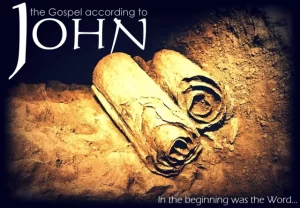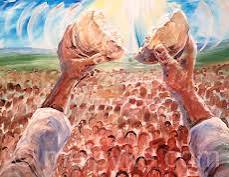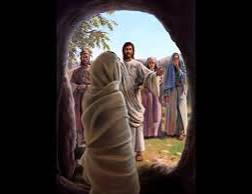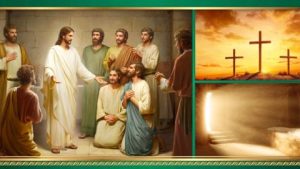
John 20: 30-31
Now Jesus did many other signs
In the presence of the disciples,
which are not written in this book;
but these are written so that
you may believe that Jesus is the Christ, the Son of God,
and that by believing you may have life in his name.
As the Apostle John wrote the Gospel According to John, he clearly intended to bring a compelling case for people to see Jesus as His Lord and Master. Jesus, as His risen Savior came as God Incarnate, as Immanuel, to offer God’s Redemption to all the people of the world. This is clearly what Jesus knew about Himself. He uses the phrase, I AM, seven times as He points to Himself as God who comes to meet the needs of His people—and most essentially, to bring them deliverance and salvation from the Son. John also gives first hand accounts as an actual witness for Jesus as He reveals His power in magnificent and miraculous acts only God-Among-Us could do.
John 2:9-11 ESV
When the master of the feast tasted the water now become wine,
and did not know where it came from
(though the servants who had drawn the water knew),
the master of the feast called the bridegroom and said to him,
“Everyone serves the good wine first,
and when people have drunk freely, then the poor wine.
But you have kept the good wine until now.”
This, the first of first of his signs, Jesus did at Cana in Galilee,
Shortly after Jesus began His ministry, He attended a wedding in Cana, where He performed His first sign. The need Jesus met at the wedding may seem less significant than some of the other signs, but in the culture of His own people, the need was crucial—to save face for close friends, possibly family members of His own mother. His actions kept them from being shamed, which carries tremendous importance. Weddings in those times reflected great joy for families. Even in those troubled times, families and friends would struggle mightily just to stage a joyful wedding celebration for everyone they knew. So, Jesus, at the urging of His mother, actually saves the day for the families involved in the wedding. And of course, the wine Jesus creates is the absolute best. Everything Jesus touches is transformed into the best of the best. Jesus among friends and family brings heavenly and perfect joy. Weddings celebrate life and the promise of new life. Jesus chooses this beautiful, this homely occasion to give the first sign of His Messianic power. And of course, Jesus later proclaims in John 15:1; “I am the vine.” Who else would have the power to miraculously transform simple, cleansing water into the very best wine?
John 4: 53-54 ESV
The father knew that was the hour when Jesus had said to him,
“Your son will live.” And he himself believed, and all his household.
This was now the second sign that Jesus did
when he had gone from Judea to Galilee.
Jesus performed His second sign in Cana, also. Note that both of these first two signs arise in the midst of the up and down daily realities people struggle to manage in life during Rome’s brutal occupation. After His shocking and yet, very successful, ministry in Samaria, Jesus returns to Cana. A royal official meets Jesus and pleads for Him to heal his seriously ill son. Here again as in His first sign, Jesus expresses some reluctance—He obviously recognizes the danger of powerful signs actually overshadowing peoples’ essential need for faith in their loving Heavenly Father as their true Lord. Yet, He has sensed that very faith in His mother; and now recognizes it in this official. So, He tells him to go his way. Praise the Lord! The official believes Jesus and sets out on his way. While traveling the twenty miles from Cana to Capernaum, the official’s servants meet him with the good news. His son had been healed. That official becomes a believer, and so does his entire household. Praise the Lord! Just as Jesus later declares in John 14:6; “I am the way, the truth, and the life.”
John 5: 6-9 ESV
When Jesus saw him lying here and knew
that he had already been there a long time
”Do you want to be healed?”
The sick man answered him, “Sir, I have no one
to put me into the pool when the water is stirred up,
and while I am going another another steps down before me.”
Jesus said to him, “Get up take up your bed, and walk.”
And at once the man was healed, and he took up his bed and walked.
Once again, in His third sign, Jesus addresses a situation which seems to be hopeless. This lame man has suffered for 38 years. Through all those years he has regularly awaited for a miraculous healing by the pool called Bethesda, within the Temple compound. At that time, It was believed that the first suffering person waiting by the pool to enter after an angel had stirred the waters, would be healed. This man, though, had no strength to enter the waters quickly enough; nor would it seem that he had any friends to help him. Jesus knows this and asks him if he wants to be healed. The miserable man explaines his desperate situation. Jesus sees the need and commands the man, “Get up, take your bed and walk.” He does. Jesus has healed him, but he seems only delighted, not grateful with his being able to walk. He is obviously unconcerned about Jesus who has healed him. Jesus even warns him, “See, you are well! Sin no more, that nothing worse may happen to you.” (John 5:14) It seems the man is still in his sin, even though he is now walking. Can you imagine that? Yet that is the reality of many who benefit so from God’s mercy in the midst of suffering, yet fail to turn in faith to the one who so blesses them. Even though Jesus has tremendous power, there is no evidence this man accepts Him as his Savior. How sad!

John 6:35 ESV
Then Jesus declared,
“I am the bread of life.
Whoever comes to me will never go hungry,
and whoever believes in me
will never be thirsty.”
John 6: 12-15 ESV
And when they had eaten their fill, he told his disciples,
”Gather up the leftover fragments, that nothing may be lost.”
So they gathered them up and filled twelve baskets with fragments
from the five barley loaves left by those who had eaten.
When the people saw the sign that he had done, they said,
”This is indeed the Prophet who is to come into the world!”
Perceiving then that they were about to come and take him by force
to make him king, Jesus withdrew again to the mountain by himself.
Jesus was sitting with His disciples, when he looked up and saw a large crowd coming to join them. Jesus asks Philip where they might get food for so many people. Philip realistically replies, “It is impossible” However, Andrew discovers a young boy with five loaves and two fish. So Jesus has the people sit down. He gives public thanks to God. They feed the five thousand men (Many believe there might have been around 15,000 people, counting women and children in addition to the 5000 men). Even the gathering of such a crowd into small groups is a mighty miracle. Then everyone eats and is satisfied. The disciples collect the left-overs and gather twelve baskets full. Jesus has provided far more than they needed. This is what Jesus does. This proves His identity as God. The crowd imagines they have a free meal ticket going forward, and want to install Jesus as a king—but He disappears and retreats to be alone with His Father for prayer. Jesus never wanted to draw attention to Himself, but He did want to validate God’s mission.. Not long after accomplishing this fourth sign, Jesus claims,three times in John, Chapter 6, “I am the bread of life.” He further claims, “Those who eat my bread will not hunger again.” He is speaking of spiritual hunger, but the crowd is much more interested in physical hunger. So Jesus hides Himself to have a time to commune His Father and our God.

John 6: 19-20
When they had rowed about three or four miles,
they saw Jesus
walking on the sea
and coming near the boat,
and they were frightened.
John 6: 16-21 ESV
When evening came, his disciples went down to the sea,
got into a boat, and started across the sea to Capernaum.
It was now dark, and Jesus had not yet come to them.
The sea became rough because a strong wind was blowing.
When they had rowed about three or four miles,
they saw Jesus walking on the sea and coming near the boat,
and they were frightened.
But he said to them, “It is I; do not be afraid.”
Then they were glad to take him into the boat,
and immediately the boat was at the land to which they were going.
Next, comes Jesus’ fifth sign. He is up on the mountain where He can talk with God privately. His disciples, as He instructed, have headed across the Sea. A storm arises. So Jesus goes to save them. Not surprisingly, Jesus’ followers are terrified when they see Jesus coming to them, walking on the water. He calmed the storm in their hearts and on the sea. Jesus called to them, “It is I. Do not be afraid.” (John 6:20) They have been with Jesus long enough to know how little they have to fear when He is with them. Still, they are overwhelmed by this demonstration of His shocking power to do what no mere man can do. His walking on the water in the midst of the storm proves to them once again how mighty their Lord Jesus is. Then suddenly they are safe at the shore. Jesus has once again intervened for His people. In twenty-four hours He has fed the multitudes of people and has calmly walked across a stormy sea to assure them they are not alone. We recall Jesus said He was the Bread of Life (John 6:35) and the Way, the Truth and the Life. (John 14:6) He clearly knows what He is saying, and we can know Him, too. So, we praise the Lord.
John 9: 30-33 ESV
The man answered, “Why, this is an amazing thing!
You do not know where he comes from, and yet he opened my eyes.
We know that God does not listen to sinners,
but if anyone is a worshiper of God and does his will, God listens to him.
Never since the world began has it been heard
that anyone opened the eyes of a man born blind.
If this man were not from God, he could do nothing.”
How sad it made Jesus when He acted in the Love and the Power of God to heal—but some of His fellow Jews bitterly complained and accused Him for healing on the Sabbath. No wonder He would eventually insist He was the Lord of the Sabbath. (Matthew 12:8) Here is a man born blind. Now as an adult he meets Jesus on the Sabbath in the Temple who gives him his sight, which is Jesus’ sixth sign. Unlike the lame man who seemed to ignore Jesus’ part in his own amazing healing; this man who now sees, tangles with the Temple officials and puts them in their place, reminding them this Jesus has power no one has ever seen before. He basically forfeits his religious identity as a Jewish man because he heroically professes his faith in Jesus. Not only has he received his physical sight, but he has also been given spiritual insight to recognize who Jesus truly is. Of course Jesus declares in John 8:12, “I am the light of the world;” and for this man born blind, He proves it.

John 11:43-44 ESV
When he had said these things,
he cried out with a loud voice,
“Lazarus, come out.”
The man who had died came out,
his hands and feet bound with linen strips,
and his face wrapped with a cloth.
Jesus said to them,
“Unbind him, and let him go.”
John 11: 41-44 ESV
So they took away the stone. And Jesus lifted up his eyes and said,
”Father, I thank you that you have heard me.
I knew that you always hear me,
but I said this on account of the people standing around,
that they may believe that you sent me.”
When he had said these things, he cried out with a loud voice,
”Lazarus, come out.”
The man who had died came out,
his hands and feet bound with linen strips,
and his face wrapped with a cloth.
Jesus said to them, “Unbind him, and let him go.”
The final of Jesus’ seven signs which radically affects peoples’ lives, also dramatically impacts His own personal life. When Jesus receives word that His dear friend, Lazarus, is seriously ill, He delays several days before heading to Bethany. Arriving there, He comes face to face with Martha and Mary’s grief, along with the horror of human death—and then in raising Lazarus from the dead, He sets in motion the sequence of events which will lead to His own death. Even in feeling In the exhilaration of having Lazarus back, and in seeing Martha and Mary’s joy—Jesus also recognizes the determination and rejection of the Jewish leaders present that day. Even raising Lazarus from the dead has not changed their hears. Though Jesus has proved His statement, “I am the resurrection and the life,” (John 11:25) the Jewish leaders’ hardened hearts can only think of Jesus as a dangerous threat to their rule. This sign becomes a day of glory for some and a day of grim reality for others. This sign draws a line in the sand. People are going to have to make a choice for Jesus as the Son of God or against Him.
John 2: 18-22 ESV
So the Jews said to him,
“What sign do you show us for doing these things?”
Jesus answered them,
“Destroy this temple and in three days I will raise it up>”
The Jews then said, “It has taken forty-six years to build this temple,
and will you raise it up in three days?”
But he was speaking about the temple of his body.
When therefore he was raised from the dead,
his disciples remembered that he had said this,
and they believed the Scripture and word that Jesus had spoken.

John 20: 19-21 ESV
Jesus came and stood among them,
“Peace be with you.”
When he had said this, he showed them
his hands and his side.
Then the disciples were glad
when they saw the Lord.
Jesus said to them again,
“Peace be with you.
As the Father has sent me,
even so I am sending you.”
Finally comes the ultimate sign. Jesus must die to follow the Father’s Will in paying for the sins of the world. Then God will raise Him from the dead in order to give irrefutable proof. All that Jesus has said and done has been God’s Work—of God and for God. And so on the Third Day after being crucified, Jesus is gloriously raised. Mary Magdalene sees Him. The Disciples see Him. The men on the road to Emmaus see Him. Over five hundred believers see Him together at one time. Later, Saul sees Him on the road to Damascus. In our own lives we see His Power, His Mercy, His Love and His Grace. We see how He brings good gifts to those in need, to the ill, to the lame, to the hungry, to the frightened, to the blind and even to the dead. And so, we fully, truly believe. “Jesus is the same, yesterday, today and forever.” (Hebrews 18:8)
From the very beginning of His ministry, as Jesus chose to be baptized by John, in obedience to the Father; Jesus as the Son of God, as the Lamb of God, walks resolutely as God leads, clearly claiming and proving with miraculous signs His identity as One with God. He spends time with His Father in prayer—seeking His Will, which He obeys. He joyfully meets the desperate needs of those He has come to serve and to save. He prayerfully chooses both His words and His deeds. He follows God’s pathway through the Garden to the Cross, into the Tomb; and gloriously, victoriously rises on the Third Day to complete His Mission—to make available salvation to all who choose to follow Him. Praise God! We are incredibly blessed to have such an incredible Lord and Savior as Jesus.

It’s a great blessing to read of the signs and miracles of Jesus again. The greatest and the sweetest of all is the gift salvation that comes through Him to the world. Glad to be a partaker of this greatest gift.